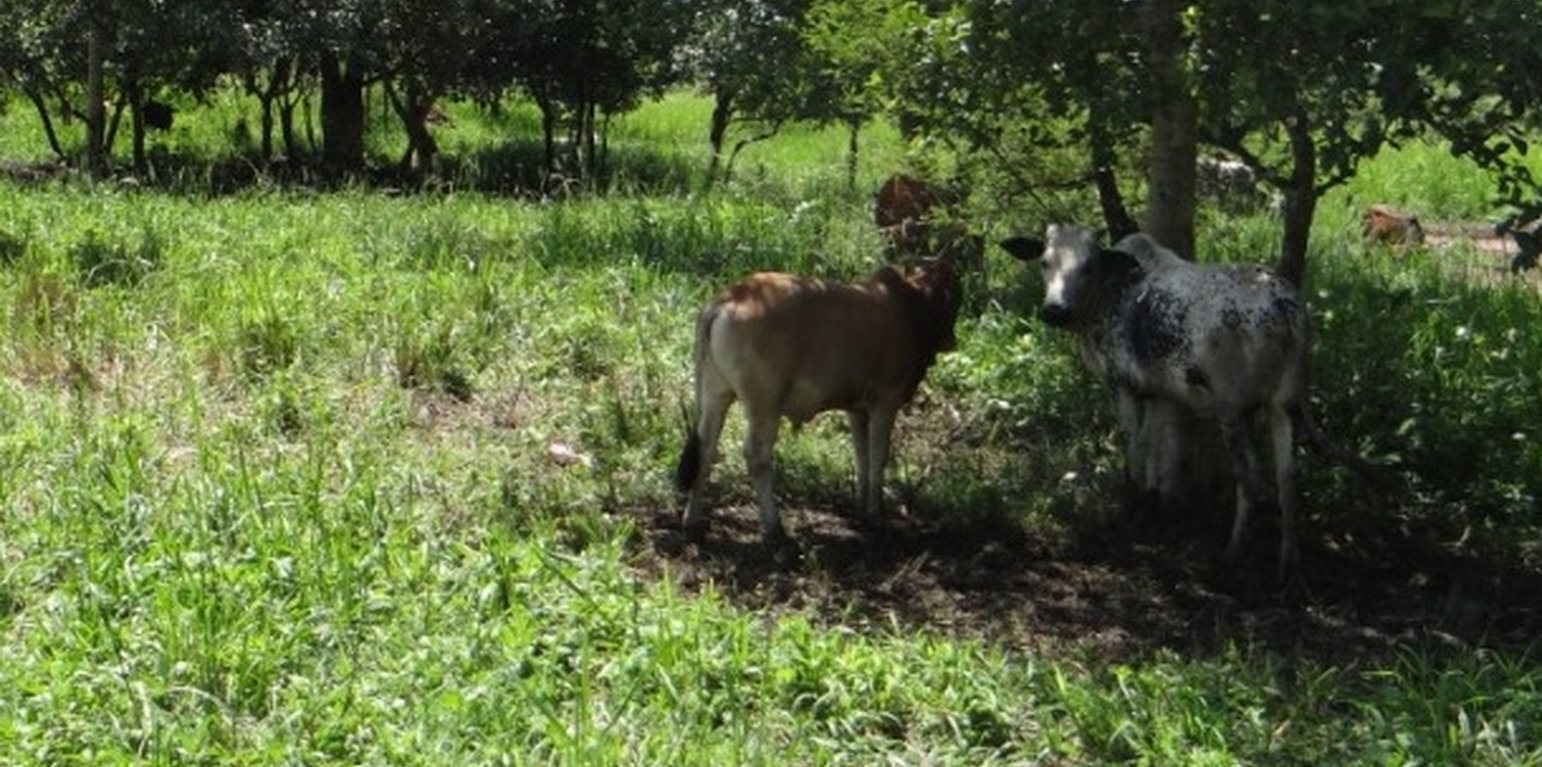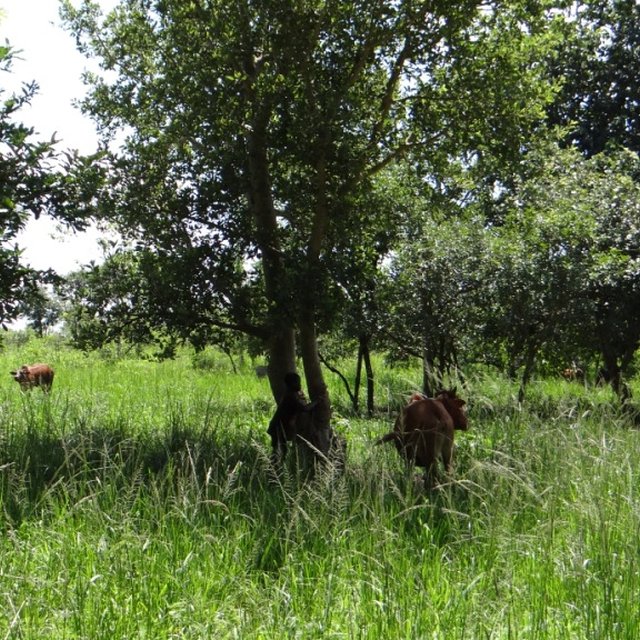



Controlled livestock grazing is a common practice promoted by farmers in Northern Uganda, who own up to 4-6 cows raised on two or more acres of land. Although the primary purpose is to produce milk for domestic consumption and for sale, the other subsidiary aim is to generate manure to replenish soil fertility on continuously cultivated and nutrient depleted land and pasture that the cows graze on. During the rainy season crops are planted and animals fed by cut and carry or pegged/ tied with a radius of 2-5 meters. During dry season the animals can graze on crop residues
For this technology, cattle are tethered/ tied on a pole (pegged) or tree using a sisal rope. Tethering distance should allow each cow to access pasture uninterrupted by others. The animals are rotated/ relocated routinely to minimise overgrazing in a given location. The manure produced is collected daily, and kept in heaps to compost for periods of 2 to 3 weeks, before being ferried to the fields for application for the cultivation of maize and other crops like soya bean . This technology requires possession of sufficient land for grazing the animals, as well as sufficient labour for handling manure through composting up to field application. The key inputs required for establishing this technology include labour, hand hoes, spades, sisal ropes, basins, sacks and basket for collecting manure and its transportation to the maize field, watering containers , spraying pumps for spraying animals against ticks and feeds to supplement the grazing during shortage of pasture.
The benefits derived from such a technology are both short and long term, including access to increased manure to apply on crop fields especially maize for increased production
To replicate this technology, the land user needs to have knowledge and skills on how to manage the animals to generate high quality manure, compost it and maintain it free of contamination with pesticides sprayed on the animals against pests and diseases, which may affect the quality of the manure and the safety of the users.

ສະຖານທີ່: Gulu Municipality, Gulu District, Northern Region, ອູເຈນດາ
ຈໍານວນ ພື້ນທີ່ ທີ່ໃຊ້ ເຕັກໂນໂລຢີ ທີ່ໄດ້ວິເຄາະ: ພື້ນທີ່ດຽວ
ການແຜ່ກະຈາຍຂອງເຕັກໂນໂລຢີ: ແຜ່ຂະຫຍາຍຢ່າງໄວວາໃນພື້ນທີ່ (approx. < 0.1 ກິໂລແມັດ2 (10 ເຮັກຕາ))
ຢູ່ໃນເຂດປ່າສະຫງວນທີ່ບໍ?:
ວັນທີຂອງການປະຕິບັດ: 2012; ຕໍ່າກວ່າ 10 ປີ ຜ່ານມາ (ມາເຖິງປະຈຸບັນ)
ປະເພດຂອງການນໍາສະເໜີ

| ສາຍພັນ | ນັບ |
| ສັດໃຫ່ຍ-ງົວພັນນົມ | 5 |



| ລະບຸ ປັດໃຈ ນໍາເຂົ້າ ໃນການຜະລີດ | ຫົວໜ່ວຍ | ປະລິມານ | ຕົ້ນທຶນ ຕໍ່ຫົວໜ່ວຍ (UGX) | ຕົ້ນທຶນທັງໝົດ ຂອງປັດໃຈຂາເຂົ້າ ໃນການຜະລິດ (UGX) | % ຂອງຕົ້ນທຶນທັງໝົດ ທີ່ຜູ້ນໍາໃຊ້ທີ່ດິນ ໃຊ້ຈ່າຍເອງ |
| ແຮງງານ | |||||
| Planting | persons | 2.0 | 150000.0 | 300000.0 | 100.0 |
| Tieing, feeding and grazing cows | persons | 2.0 | 150000.0 | 300000.0 | 100.0 |
| ອຸປະກອນ | |||||
| Hoe | pieces | 1.0 | 10000.0 | 10000.0 | 100.0 |
| Spade | peices | 1.0 | 10000.0 | 10000.0 | 100.0 |
| Spraying pump | pieces | 1.0 | 250000.0 | 250000.0 | 100.0 |
| Watering trays | pieces | 6.0 | 100000.0 | 600000.0 | 100.0 |
| ວັດສະດຸໃນການປູກ | |||||
| Maize seed | Kgs | 10.0 | 2500.0 | 25000.0 | 100.0 |
| ອື່ນໆ | |||||
| Local cows | cow | 6.0 | 700000.0 | 4200000.0 | |
| Buckets | pieces | 1.0 | 3500.0 | 3500.0 | 100.0 |
| Sack | pieces | 2.0 | 1000.0 | 2000.0 | 100.0 |
| Feeds | Kgs | 100.0 | 4000.0 | 400000.0 | 100.0 |
| Crop residues (not bought) | |||||
| ຕົ້ນທຶນທັງໝົດ ໃນການຈັດຕັ້ງປະຕິບັດ ເຕັກໂນໂລຢີ | 6'100'500.0 | ||||
| ຄ່າໃຊ້ຈ່າຍທັງໝົດ ສຳລັບການສ້າງຕັ້ງເຕັກໂນໂລຢີ ເປັນສະກຸນເງີນໂດລາ | 1'770.83 | ||||
| ລະບຸ ປັດໃຈ ນໍາເຂົ້າ ໃນການຜະລີດ | ຫົວໜ່ວຍ | ປະລິມານ | ຕົ້ນທຶນ ຕໍ່ຫົວໜ່ວຍ (UGX) | ຕົ້ນທຶນທັງໝົດ ຂອງປັດໃຈຂາເຂົ້າ ໃນການຜະລິດ (UGX) | % ຂອງຕົ້ນທຶນທັງໝົດ ທີ່ຜູ້ນໍາໃຊ້ທີ່ດິນ ໃຊ້ຈ່າຍເອງ |
| ແຮງງານ | |||||
| Labour paid on monthly basis | Persons | 2.0 | 150000.0 | 300000.0 | 100.0 |
| ອຸປະກອນ | |||||
| Replacement worn our equipment | pieces | 3.0 | 20000.0 | 60000.0 | 100.0 |
| ຝຸ່ນ ແລະ ຢາຊີວະພາບ | |||||
| Pestcide | litres | 10.0 | 15000.0 | 150000.0 | 100.0 |
| ຕົ້ນທຶນທັງໝົດ ທີ່ໃຊ້ໃນການບໍາລຸງຮັກສາ ເຕັກໂນໂລຢີ | 510'000.0 | ||||
| ຄ່າໃຊ້ຈ່າຍທັງໝົດ ສຳລັບການບົວລະບັດຮກສາເຕັກໂນໂລຢີ ເປັນສະກຸນເງີນໂດລາ | 148.04 | ||||
Milk production and the farmer has also increased the number of cows.
Application of locally obtained manure.
More money spent on buying pesticides, basins, buckets, and maize seed.
From sale of maize and milk.
More activities during establishment.
Availability of Maize after harvest for sale and household income.
Training on manure application in the maize field.
Use of manure and maize stalks.
Application of manure and decomposition of maize stalks.
Restricted movements of the cows